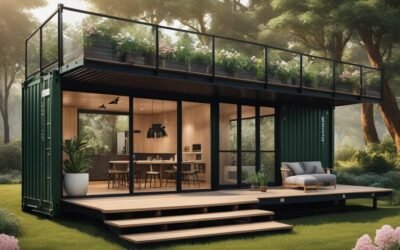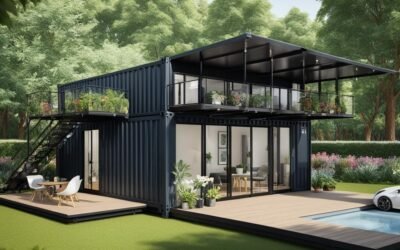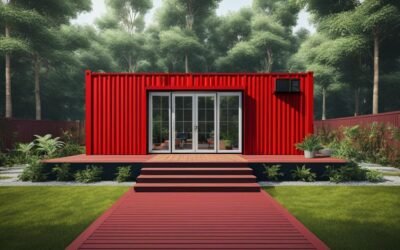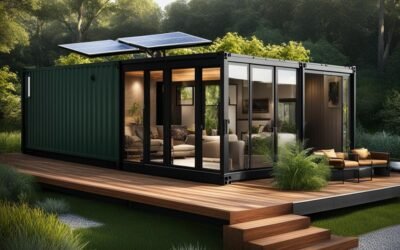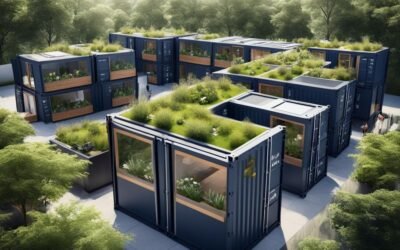In a world increasingly fascinated by the concept of minimalism and the appeal of a simpler lifestyle, there’s one trend that stands out: Tiny Container Homes. A unique fusion of architectural innovation and practical functionality, these homes offer a fresh perspective on what it means to live comfortably with less. Exemplifying the Tiny Living movement, container homes are marking their footprint as a promising alternative living option. This discourse will dive deep into the world of tiny container homes, offering an all-rounded understanding of its concept, benefits, challenges, design aspects, and inspiring real-life examples.
Key Takeaways:
- Cargo houses, also known as container homes, provide a unique approach to minimalistic living and optimization of space.
- The concept of tiny container homes revolves around effective use of space and the utilization of shipping containers as the base building block.
- Tiny container homes have evolved from being unconventional housing options to stylish, fully functional homes with modern amenities.
- These homes offer compactness, adaptability, and portability, making them a suitable choice for those seeking a sustainable and off-grid living experience.
- However, challenges such as limited space, potential legal barriers, and the need for effective insulation must be considered when opting for a container home.
Understanding the Concept of Tiny Container Homes
The concept of tiny housing revolves around the idea of minimalism and effective use of space, aiming to live smartly with less. Essentially, tiny container homes fall under this industry’s umbrella, leveraging the structure of shipping containers as the base building block. They are compact and portable habitats designed and customized according to the owner’s requirements.
Minimalism at its Finest
Tiny container homes encapsulate the essence of minimalism, embracing the philosophy of living with less. These compact dwellings prioritize the elimination of unnecessary clutter, allowing individuals to focus on the essentials and create a serene living environment.
Effective Use of Space
One of the key advantages of tiny container homes is their efficient utilization of space. With limited square footage, every nook and cranny is carefully designed to serve a purpose. From multi-functional furniture to creative storage solutions, these homes maximize the available area, ensuring functionality without sacrificing comfort.
“Tiny container homes revolutionize the notion of traditional living spaces, offering a compact yet comfortable alternative for individuals seeking a minimalist lifestyle.”
Compact and Portable
Tiny container homes are not only compact but also portable. Their modular design allows for convenient relocation, giving homeowners the flexibility to move their living space to a new location if desired. This portability adds a unique dimension to the concept of home ownership, granting individuals the freedom to explore different environments while still enjoying the comforts of their personal space.
Customization and Personalization
Despite their size constraints, tiny container homes offer ample opportunities for customization. Owners have the freedom to design and personalize their living space to suit their preferences, whether it’s creating a cozy reading nook or incorporating unique architectural features. This ability to transform a small structure into a personalized sanctuary makes tiny container homes truly special.
Next, we will delve into the origin and evolution of tiny container homes, exploring how this housing trend has evolved over time and gained popularity among those seeking unconventional living solutions.
Origin and Evolution of Tiny Container Homes
 The idea of using a shipping container as a living space was not widely accepted until a decade ago. With the rise of the tiny house movement in the late 20th century, individuals began experimenting with unconventional types of housing, among which was the shipping container. They were an attractive option due to their structural stability, affordability, and modular nature. Over time, these residences evolved from makeshift accommodations to stylish, fully functional homes with all modern amenities.
The idea of using a shipping container as a living space was not widely accepted until a decade ago. With the rise of the tiny house movement in the late 20th century, individuals began experimenting with unconventional types of housing, among which was the shipping container. They were an attractive option due to their structural stability, affordability, and modular nature. Over time, these residences evolved from makeshift accommodations to stylish, fully functional homes with all modern amenities.
The tiny house movement, as a cultural phenomenon, gained momentum as people sought alternative ways of living that prioritized minimalism and sustainability. Shipping containers, originally designed for transportation, proved to be a practical solution for creating unconventional housing. Their sturdy steel construction made them structurally stable, while their modular nature allowed for endless possibilities in terms of design and layout.
Container homes offered a more affordable housing option, particularly for individuals looking to downsize or minimize their environmental impact. Repurposing shipping containers not only reduced construction costs but also repurposed materials that would otherwise go to waste.
The emergence of tiny container homes reflects a growing desire to deviate from traditional housing norms and embrace a more sustainable way of living. By repurposing shipping containers, individuals have found a creative solution that combines affordability, design flexibility, and environmental consciousness.
As the concept gained popularity, container homes became more than just makeshift dwellings. Architects and designers began pushing the boundaries of container home design, creating innovative and inspiring spaces that challenged the perception of what a home should look like.
Container homes have emerged as a testament to human ingenuity and our ability to transform unconventional materials into livable, unique spaces. They are a tangible representation of the exploration and evolution of housing options, offering individuals the opportunity to live in an unconventional, yet stylish and functional, way.
Features and Appeal of Tiny Container Homes
 The primary appeal of tiny container homes lies in their compactness and adaptability. These homes are often designed to optimize space, meaning every inch is used for practical purposes like storage or dual-functionality fixtures. Furthermore, they have the added advantage of portability, as they can be dismantled and relocated if needed.
The primary appeal of tiny container homes lies in their compactness and adaptability. These homes are often designed to optimize space, meaning every inch is used for practical purposes like storage or dual-functionality fixtures. Furthermore, they have the added advantage of portability, as they can be dismantled and relocated if needed.
Nowadays, tiny container homes are highly personalized and are often designed to reflect the owner’s personality. The trend leans towards incorporating sustainable features such as solar panels, rainwater collection systems, and compostable toilets. Additionally, there is a growing interest in off-grid container homes, which aim to be entirely self-sufficient and independent from any external utilities.
In terms of design, many container homes utilize multi-level designs, with containers stacked or joined together. Interiors often boast open-plan designs to maximize space and create a sense of larger living areas. Glass walls or large windows are frequently integrated to allow natural light in and create an indoor-outdoor living experience.
| Appealing Features | Description |
|---|---|
| Compactness | Utilizes space efficiently by optimizing every inch for practical purposes |
| Adaptability | Customizable and reflects the owner’s personality and preferences |
| Portability | Can be dismantled and relocated if needed |
| Sustainable Features | Incorporates eco-friendly elements like solar panels and rainwater collection systems |
| Off-Grid Container Homes | Designed to be self-sufficient and independent from external utilities |
| Multi-Level Designs | Utilizes stacked or joined containers to maximize space |
| Open-Plan Designs | Creates a sense of larger living areas and maximizes space |
| Natural Light | Integrates glass walls or large windows to allow ample natural light |
Benefits and Challenges of Tiny Container Homes
 The appeal of tiny container homes lies in their multiple benefits, particularly for those aspiring to adopt a minimalist lifestyle or reduce their ecological footprint. These homes offer a cost-effective and eco-friendly housing solution that merges seamlessly with minimalist principles. However, they do come with unique challenges that need to be considered.
The appeal of tiny container homes lies in their multiple benefits, particularly for those aspiring to adopt a minimalist lifestyle or reduce their ecological footprint. These homes offer a cost-effective and eco-friendly housing solution that merges seamlessly with minimalist principles. However, they do come with unique challenges that need to be considered.
Benefits of Tiny Container Homes
- Cost-effectiveness: Repurposing shipping containers into livable spaces significantly lowers the initial building costs compared to traditional alternatives. This makes tiny container homes a budget-friendly option for homeowners.
- Eco-friendly: By their nature, container homes require fewer resources for heating and cooling, reducing energy consumption and greenhouse gas emissions. They offer a sustainable housing choice for environmentally conscious individuals.
- Minimalist lifestyles: Tiny container homes encourage living with less and maximizing the utility of available space. They provide an ideal living environment for those embracing a clutter-free and simplified lifestyle.
- Portability: One of the key advantages of container homes is their portability. These homes can be easily relocated, allowing homeowners to take their living space with them wherever they go.
Challenges of Tiny Container Homes
While tiny container homes offer various benefits, there are also challenges associated with these unique living spaces:
- Limited space: The compact size of container homes means that space is limited, requiring careful planning and organization to make the most of the available area.
- Legal barriers: Depending on local regulations, there may be legal barriers to overcome when building or placing container homes. It is essential to research and understand the legalities and zoning requirements beforehand.
- Insulation: Proper insulation is crucial in container homes to regulate temperature and ensure comfortable living conditions. Effective insulation techniques must be employed to address potential issues with heat transfer.
Despite these challenges, the benefits outweigh the limitations for many individuals seeking an affordable, eco-friendly, and minimalist living solution.
Conclusion
Embracing the concept of shipping container homes offers a plethora of advantages that make it an appealing choice for those seeking a unique and sustainable living experience. One of the key benefits is affordability, as repurposing shipping containers significantly lowers the initial building costs compared to traditional alternatives. This cost-effectiveness allows individuals to realize their dream of homeownership without breaking the bank.
Another notable advantage of shipping container homes is their energy efficiency. With proper insulation and strategic design, these homes can effectively regulate the interior temperature, reducing the need for excessive heating or cooling. This not only minimizes energy consumption but also contributes to a more eco-friendly and sustainable lifestyle.
Moreover, the customization options available with shipping container homes are virtually limitless. Homeowners can personalize their living space according to their needs, preferences, and creative vision. Whether it’s configuring the layout, adding unique architectural elements, or incorporating smart home technology, customization ensures that every container home is as unique as its owner.
Lastly, maintenance requirements for shipping container homes are relatively low. The durable nature of shipping containers means they can withstand harsh weather conditions, making them a sturdy and long-lasting housing solution. Routine maintenance, such as regular inspections and occasional exterior touch-ups, can keep the container home looking pristine for years to come, allowing homeowners to spend less time on maintenance and more time enjoying their custom-designed space.
FAQ
What is a cargo house?
A cargo house, also known as a shipping container home, is a form of housing that utilizes repurposed shipping containers as the primary building blocks for residential structures.
What services do shipping companies provide?
Shipping companies offer a range of services including freight forwarding, logistics solutions, warehouse management, transportation, and international shipping.
What is the concept behind tiny container homes?
Tiny container homes embrace the concept of minimalism and effective use of space, offering compact and portable habitats designed and customized based on individual requirements.
How did the tiny container home trend originate?
The tiny container home trend emerged with the rise of the tiny house movement, which began exploring unconventional types of housing, including repurposing shipping containers due to their structural stability, affordability, and modular nature.
What are the features and appeal of tiny container homes?
Tiny container homes are highly desirable for their compactness, adaptability, optimized space utilization, portability, and sustainable features. They often incorporate multi-level designs, open-plan layouts, and the integration of natural light.
What are the benefits and challenges of tiny container homes?
Tiny container homes offer benefits such as cost-effectiveness, eco-friendliness, and the promotion of minimalist lifestyles. However, challenges may include limited space, potential legal barriers, and the need for effective insulation.
What is the conclusion about tiny container homes?
Tiny container homes provide an opportunity to optimize lifestyle choices with their energy efficiency, customization options, and low-maintenance living.








